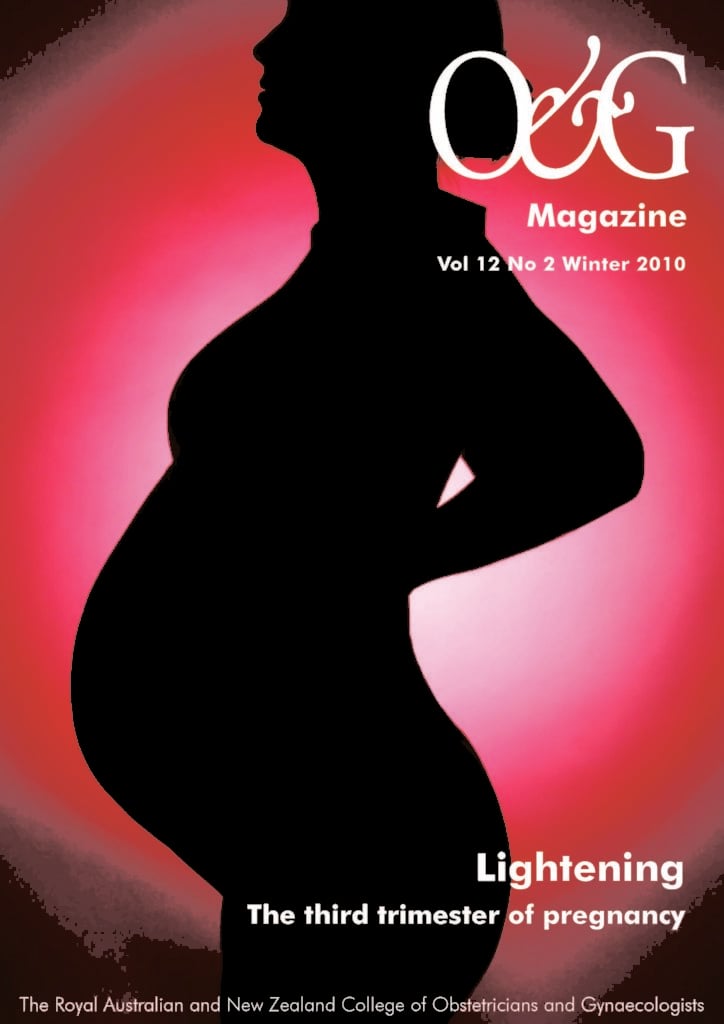Despite the advent of evidence-based medicine, controversy can exist when there is a paucity of evidence to guide practice, or when there is conflicting evidence. Further confusion arises when guidelines from different resources recommend different practices. Within infectious diseases, controversies exist in areas including screening, prophylaxis, treatment and/or vaccination of pregnant women against pathogens such as group B streptococcus (GBS), influenza, herpes simplex virus (HSV), varicella zoster virus (VZV) and human immunodeficiency virus (HIV).
The perinatal management of GBS remains controversial, as debate continues over the optimal approach (universal versus risk-based screening) and the efficacy of intrapartum antibiotic prophylaxis (IAP) in preventing GBS infection. Retrospective data suggest that screening confers a lower risk of early onset GBS infection (EOGBS) compared to a risk-based approach (relative risk 0.46).15 Although the adoption of universal screening and IAP did reduce the incidence of EOGBS, one study showed that 61.4 per cent of term infants with EOGBS were born to mothers who had negative screen results20, highlighting the need to develop other preventive strategies such as vaccination. Furthermore, the largest meta-analysis examining the use of IAP to date demonstrated that although IAP use in women colonised with GBS reduced EOGBS, it did not significantly reduce the incidence of all cause mortality or morbidity from GBS infection.11 Unfortunately, the studies included in this meta-analysis were either of poor quality (lack of placebo or changing statistical methods post-hoc to demonstrate significance) or had significant biases (exclusion of infants whose mothers developed intrapartum fever or imbalance of study participants). At present, due to inconclusive and conflicting evidence, RANZCOG recommends either screening or a risk-based approach and IAP to prevent EOGBS.18
Pregnant women are at increased risk of developing severe influenza infection, with increased mortality rates and obstetric complications, including preterm labour and spontaneous miscarriages.5,7 During the 2009 Australasian influenza season, 9.1 per cent of all patients (or 17.6 per cent of women) admitted to intensive care units (ICu) with pandemic (H1N1) 2009 influenza were pregnant.17 A four-fold increase in the risk of ICu admission or death was also noted when the institution of oseltamivir was delayed beyond 48 hours after initial presentation.9 Despite the benefits of oseltamivir (a category B1 medication), only 50 to 81 per cent 5,7,9 of hospitalised pregnant women with pandemic influenza received oseltamivir. The safety of oseltamivir is still in question, given the limited information about its safety and efficacy in pregnancy13, and it is only recommended by the manufacturer if the potential benefit justifies the potential risk to the fetus. Nevertheless, the dose of oseltamivir administered in some hospitalised patients was twice the normal recommended dose.9
Australian guidelines recommend trivalent seasonal influenza vaccination for all pregnant women who will be in the second or third trimester of pregnancy during the influenza season.1 The monovalent influenza A pandemic (H1N1) 2009 vaccine was also recommended for pregnant women when it became available in September 2009 and is included in the 2010 seasonal vaccine. The influenza vaccine protects pregnant women in their third trimester against febrile respiratory illnesses and reduces laboratory-confirmed cases of influenza in infants of vaccinated mothers.22 No significant long-term side effects (teratogenic, carcinogenic or neurologic) have been shown in pregnant women receiving the influenza vaccine during the first trimester10 and would not be expected from a killed vaccine. However, the uptake of the vaccine in pregnant women, even in the later stages of pregnancy, is universally poor despite evidence of significantly increased morbidity from influenza infection.5
Although antiviral therapy is recommended for primary genital herpes simplex virus (HSV) infection at any stage of pregnancy, the risk of HSV infection in neonates born to mothers with primary genital HSV infection who seroconvert before delivery is very low, in contrast to the high (up to 50 per cent) risk of neonatal infection when mothers acquire HSV infection just prior to delivery.2 This suggests that antiviral therapy for primary HSV infection occurring well before the onset of labour should be based on maternal clinical indications, bearing in mind that maternal fever and toxicity can precipitate the onset of premature labour. In pregnant women with recurrent genital herpes, aciclovir or valaciclovir use during the last four weeks of pregnancy reduces maternal recurrences, viral shedding and rates of caesarean delivery, but not neonatal HSV infection.6 Aciclovir (category B3 medication) use is still not recommended in pregnancy unless potential benefits clearly outweigh the potential risk to the fetus4, despite extensive data showing no increased risk of teratogenicity.16 Interestingly, the evidence for caesarean delivery to protect against neonatal infection, which is recommended for primary HSV infection and where active lesions are present in pregnant women with pre-existing infection, was only available long after it became standard practice.3
Pregnant women without a definite history of varicella should be tested for varicella IgG antenatally or following an exposure to chicken pox in order to guide further management. Antenatal screening with postnatal vaccination has been shown to be more cost-effective than using zoster immunoglobulin (ZIG) for seronegative women.19 A previous seroprevalence study showed that 86 per cent and 96 per cent of pregnant women with no history or an unclear history of previous VZV infection respectively were seropositive when tested.8 However, the use of serology is not recommended to document seroconversion in patients who have previously received adequate varicella vaccination, as current methods of antibody detection using enzyme immunoassays are insensitive in reliably detecting vaccine-induced antibodies.14 Post-exposure prophylaxis with ZIG aims to prevent or attenuate maternal varicella, which can be severe or even life-threatening, especially in the third trimester. There is little evidence that it affects congenital varicella syndrome, following maternal VZV exposure in the first or second trimester, unless it prevents, rather than reduces the severity of maternal infection. ZIG is also given to prevent neonatal varicella following maternal exposure in the perinatal period. The optimal timing for ZIG administration is the first 48 to 72 hours after exposure, although it may modify severity of disease, up to ten days post exposure.1 The use of ZIG in pregnant women who have been previously vaccinated but with undetectable antibody levels (if tested) is highly contentious, although previously reported breakthrough varicella infections following vaccination would support its use. For pregnant women not given ZIG, aciclovir may be considered as post-exposure prophylaxis, although evidence for this strategy is lacking.
The goal of antiretroviral therapy in HIV-infected pregnant women is to achieve maximal viral suppression, in order to prevent mother-to-child transmission of HIV. Although zidovudine is generally recommended as part of the antiretroviral regimen (unless severe toxicity occurs or resistance is documented), patients already on antiretroviral therapy are usually continued on their pre-existing regimens (with the exception of efavirenz during the first trimester due to its potential teratogenicity) provided their HIV infection is well controlled. Controversially, zidovudine monotherapy has been suggested for antiretroviral naïve pregnant-women who have HIV RNA levels below 1000 copies/ml, to limit unnecessary antiretroviral exposure, as the short and long-term fetal effects of many antiretroviral drugs remain unknown. However, combination antiretroviral therapy reduces perinatal transmission more than zidovudine alone.12 In addition, there were no short-term differences in CD4 T-cell counts, viral load or disease progression in antiretroviral naïve patients (with CD4 T-cell counts greater than 350 cells/mm3) who continued or stopped antiretroviral therapy that was commenced during pregnancy to prevent mother-to-child transmission.21
In conclusion, many questions and issues remain unanswered and unresolved in the management of infectious diseases in the third trimester. until conclusive evidence can be obtained to guide clinical practice, management is likely to be based on ‘expert’ opinion, which remains a concoction of intuition, anecdotes and experience.
References
- Australian Government Department of Health and Aging. 2008. The Australian Immunisation Handbook 9th Edition 2008 (Accessed March 5, 2010 at: www.health.gov.au/internet/immunise/publishing.nsf/Content/Handbook-specialrisk232).
- Brown ZA, Selke S, Zeh J, Kopelman J, Maslow A, Ashley RL, Watts DH, Berry S, Herd M and Corey L. The acquisition of herpes simplex virus during pregnancy. N Engl J Med. 1997; 337:509-515.
- Brown ZA, Wald A, Morrow RA, Selke S, Zeh J and Corey L. Effects of serologic status and Cesarean delivery on transmission rates of herpes simplex virus from mother to infant. JAMA. 2003; 289:203-209.
- GlaxoSmithKline. 2006. ZOVIRAX™ (Aciclovir) Product Information (Accessed March 25, 2010 at: www.gsk.com.au/resources.ashx/prescriptionmedicinesproductschilddataproinfo/819/FileName/48 48CEB0CDECBA9085768E3FE5A2244F6C/PI_ZoviraxIV.pdf).
- Hewagama S, Walker SP, Stuart RL, Gordon C, Johnson P, Friedman N, O’Reilly M, Cheng A and Giles M. 2009 H1N1 Influenza A and pregnancy outcomes in Victoria, Australia. Clin Inf Dis. 2010; 50:686-690.
- Hollier LM and Wendel GD. Third trimester antiviral prophylaxis for preventing maternal genital herpes simplex virus (HSV) recurrences and neonatal infection. Cochrane Database Syst Rev. 2008. 2:1-20.
- Jamieson D, Honein M, Rasmussen S, et al. H1N1 2009 influenza virus infection during pregnancy in the uSA. Lancet. 2009; 374:451-458.
- Karunajeewa H, Siebert D, Hammond R, Garland S and Kelly
H. Seroprevalence of varicella zoster virus, parvovirus B19 and Toxoplasma gondii in a Melbourne obstetric population: Implications for management. Aust N Z J Obstet Gynaecol. 2001; 41:23-28. - Louie J, Acosta M, Jamieson D and Honein M. Severe 2009 H1N1 Influenza in pregnant and postpartum women in California. N Engl J Med. 2010; 362:27-35.
- Mak T, Mangtani P, Leese J, Watson J and Pfeifer D. Influenza vaccination in pregnancy: current evidence and selected national policies. Lancet Infect Dis. 2008; 8:44-52.
- Ohlsson A and Shah V. Intrapartum antibiotics for known maternal Group B streptococcal colonization. Cochrane Database Syst Rev. 2009; 3:1-35.
- Perinatal HIV Guidelines Working Group. 2009. Public Health Service Task Force Recommendations for use of Antiretroviral Drugs in Pregnant HIV-Infected Women for Maternal Health and Interventions to Reduce Perinatal HIV Transmission in the united States (Accessed March 15, 2010 at: http://aidsinfo.nih.gov/ContentFiles/PerinatalGL. pdf).
- Roche Products Pty Ltd. 2009. TAMIFLu® (oseltamivir) Product Information (Accessed March 23, 2010 at: www.roche-australia.com/downloads/tamiflu-pi.cfm?action=get).
- Sauerbrei A and Wutzler P. Herpes simplex and varicella-zoster virus infections during pregnancy: current concepts of prevention, diagnosis and therapy. Part 2: Varicella-zoster virus infections. Med Microbiol
Immunol. 2007; 196:95-102. - Schrag S, Zell E, Lynfield R, Roome A, Arnold K, Craig A, Harrison L, Reingold A, Stefonek K, Smith G, Gamble M and Schuchat A. A population-based comparison of strategies to prevent early-onset group B streptococcal disease in neonates. N Engl J Med. 2002; 347:233-239.
- Stone K, Reiff-Eldridge R, White A, Cordero J, Brown Z, Alexander
E and Andrews E. Pregnancy outcomes following systemic prenatal acyclovir exposure: Conclusions from the international acyclovir pregnancy registry, 1984-1999. Birth Defects Res A Clin Mol Teratol. 2004; 70:201-207. - The ANZIC Influenza Investigators. Critical Care Services and 2009 H1N1 Influenza in Australia and New Zealand. N Engl J Med. 2009; 361:1925-1934.
- The Royal Australian and New Zealand College of Obstetricians and Gynaecologists. 2009. Screening and Treatment of Group B Streptococcus in Pregnancy (Accessed March 8, 2010 at: www.ranzcog.edu.au/publications/statements/C-obs19.pdf).
- Troughton J, Crealey G, Crawford V and Coyle P. Management of varicella contacts in pregnancy: VZIG or vaccination? J Clin Virol. 2009; 46:345-348.
- Van Dyke M, Phares C, Lynfield R, Thomas A, et al. Evaluation of universal antenatal screening for group B streptococcus. N Engl J Med. 2009; 360:2626-2636.
- Watts D, Lu M, Thompson B, Tuomala R, et al. Treatment interruption after pregnancy: effects on disease progression and laboratory findings. Infect Dis Obstet Gynecol. 2009:456717.
- 22. Zaman K, Roy E, Arifeen S, Rahman M, et al. Effectiveness of maternal influenza immunization in mothers and infants. N Engl J Med. 2008; 359:1555-1564.







Leave a Reply